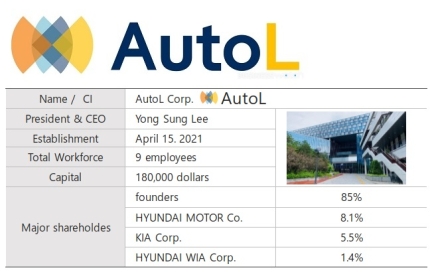Share AutoL's technology and news.
- MEDIA
- NEWS
NEWS
Significant Expansion of the LiDAR Market Within 5 Years (2)
Interview with CEO Lee Yong-sung of AutoL "Challenging Corporate Spin-off to Reduce Startup Risks" Continuation from Part 1: "Creating a Ground for Young People to Challenge Freely"
When asked if AutoL plans to enter other business areas, CEO Lee Yong-sung mentioned, "The LiDAR sensor currently under development is primarily focused on premium products for autonomous vehicles," and he added, "The market for automotive LiDAR is expected to significantly expand in five years." He expressed plans to venture into LiDAR for delivery robots or logistics robots. He stated, "After developing LiDAR sensors for automobiles and accumulating experience, we plan to grow into a company that supplies LiDAR products for various purposes by developing affordable products."
"We will create a foundation for freely challenging new technologies."

It is known that AutoL was established through Hyundai Motor Group's in-house startup nurturing program called 'Zero One Company Builder.' I'd like to know how the AutoL team was formed and the process leading up to the spin-off.
▲ In the past, when researching autonomous vehicles at Hyundai Motor Central Research Institute, we imported and used LiDAR sensors from overseas. At that time, LiDAR was unfamiliar in Korea, and it was challenging to find domestic companies capable of understanding and applying the principles to develop products. However, overseas LiDAR sensors were not excellent in terms of price, size, and performance.
Recognizing the need for a LiDAR sensor suitable for mass production for the commercialization of autonomous driving technology, we decided to embark on in-house development. We concluded that we should try the development process ourselves, and, along with Hyundai Motor and group company personnel, applied for the in-house startup nurturing program.
What kind of support did AutoL receive from Hyundai Motor Group?
▲ When selected as an in-house startup, initial support is provided for the budget required for product development. In addition, there are educational and consulting service programs for legal, labor, and accounting matters, including writing business plans and attracting investments (IR pitching). Even after the spin-off, Hyundai Motor continues to invest a certain stake, maintaining a sustained collaborative relationship. If the company closes within three years, employees can return to their original affiliated companies.
This setup allows startups to attempt various initiatives. There is also a system recommending government policy funds supporting startups, providing significant assistance in the early stages of business operations.
Nevertheless, there must have been many challenges in the startup process.
▲ After the spin-off, it always felt like riding a unicycle. To avoid falling, you have to keep pedaling while considering where to go so that the wheel does not get stuck in a pothole. There were many difficulties in the startup process. Although there were many twists and turns in the development process, the biggest challenge occurred when two colleagues who were preparing for the startup had to return to the company due to personal reasons. They were responsible for tasks that required expertise, and even if someone else took over, the development process had to start from scratch. This meant that we couldn't meet the original spin-off schedule. The most significant challenge was when these colleagues expressed their intention to return to the company. Apparently, there was opposition from their families. It seems that this was due to concerns about leaving the stable environment of Hyundai Motor to embark on a new challenge in a startup. It was a collision with the inherent disadvantage of startups, which is instability.
Through this experience, I felt the need to realistically balance the risk and opportunity factors of startups. In this process, we made it possible for a limited number of people to choose options with less risk, even if it meant reducing opportunities for some individuals. Fortunately, with this proposal, we were able to convince the developers, and all members participated until the end. Currently, key technical personnel needed for development have been recruited, and we are progressing faster to implement the targeted technology.
What are the short-term and long-term goals you want to achieve within the next year?
▲ The business goal within one year is to produce LiDAR samples with secured performance and durability, generate sales, and provide samples to first-tier suppliers for evaluation, aiming to be recognized for performance. Subsequently, select the vehicle type for mass production, supply samples that meet the vehicle's specifications on time over about two years, and improve quality. If this process is successfully executed, it is expected to apply mass production to finished vehicles in 2024. This is the primary goal.
In the long term, the ultimate goal is to create a foundation for young talents who want to unleash their potential and freely attempt new technologies and challenges to implement new mobility environments in the future.
View original article : https://post.naver.com/viewer/postView.naver?volumeNo=32086855&memberNo=997329

